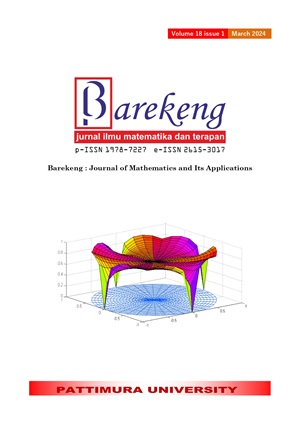PREDICTIVE DISTRIBUTION TO DETERMINE LEARNING MODEL AT THE STRATEGIC COMPETENCE LEVEL OF STUDENTS IN STATISTICS GROUP COURSE
Abstract
The problem of this research comes from a situation or condition that is not static. The description of these problems is the condition of the learning system, which tends to change due to the Covid-19 pandemic, causing learning conditions to be dynamic. From a statistical perspective, the dynamic situation can be modeled using a predictive distribution approach, so its characteristics can be studied. The purpose is to provide policy recommendations on appropriate learning models for lecturers in improving students' strategic competence, which is an ability that students need to master in solving various mathematical problems. The main discussion of this paper consists of three parts: clustering, predictive distribution, and statistical inference. The purpose of clustering is to group students based on test results to determine the level of strategic competence. In addition, clustering is also used as an initial process to predict students' strategic competence level if the learning used is still the same. The benefits of statistical inference in the distribution procedure in this study are used to determine the type of data distribution from each arrival of new information or data. The results of the statistical inference determine whether or not it is necessary to update the learning model of the lecturer. This research produce a new alternative statistical inference needed to make decisions. Based on the simulation results and discussion, the use of a predictive distribution approach to predict dynamic data is very appropriate. Distribution approach can use for detecting changes in new data distribution with historical data for the dynamic condition. If the changes are insignificant, direct instruction can still be used for the learning model in statistics course. A new learning model is recommended for the statistics group course at a higher level when the changes are significant.
Downloads
References
J. Kilpatrick, J. Swafford, and B. Findell, Adding It Up: Helping Children Learn Mathematics. 2002.
K. E. Lestari, M. R. Utami, and M. R. Yudhanegara, “Exploratory Analysis on Adaptive Reasoning of Undergraduate Student in Statistical Inference,” Int. J. Intruction, vol. 15, no. 4, pp. 535–554, 2022, doi: 10.4135/9780857020123.n561.
M. R. Yudhanegara, S. W. Indratno, and R. K. N. Sari, “Dynamic items delivery network: prediction and clustering,” Heliyon, vol. 7, no. 5, p. e06934, 2021, doi: 10.1016/j.heliyon.2021.e06934.
S. W. Indratno, K. N. Sari, and M. R. Yudhanegara, “Optimization in Item Delivery as Risk Management: Multinomial Case Using the New Method of Statistical Inference for Online Decision,” Risks, vol. 10, no. 6, p. 122, 2022, doi: 10.3390/risks10060122.
S. A. Klugman, H. H. Panjer, and G. E. Willmot, Loss Models: From Data to Decisions, 5th Edition. 2019.
R. V. Hogg and A. T. Craig, Introduction to Mathematical and Statistics., vol. 67, no. 7. Pearson, 2019.
M. R. Yudhanegara and K. E. Lestari, “Clustering for multi-dimensional data set: A case study on educational data,” J. Phys. Conf. Ser., vol. 1280, no. 4, 2019, doi: 10.1088/1742-6596/1280/4/042025.
J. Oosterhoff, “The Likelihood Ratio Test for the Multinomial Distribution,” Theory Stat., pp. 31–50, 2020, doi: 10.1525/9780520325883-004.
L. A. B. Owen, “Lecture 10 : Generalized likelihood ratio test Generalized likelihood ratio test Multinomial,” vol. 2018, pp. 1–5, 2018.
C. D. Lewis, Industrial and Business Forecasting Methods. London: Butterworths, 1982.
M. R. Yudhanegara, S. W. Indratno, and R. R. K. N. Sari, “Clustering for Items Distribution Network,” J. Phys. Conf. Ser., vol. 1496, no. 1, 2020, doi: 10.1088/1742-6596/1496/1/012019.
M. R. Yudhanegara, S. W. Indratno, and R. K. N. Sari, “Clustering for Item Delivery Using Rule-K-Means,” J. Indones. Math. Soc., vol. 26, no. 2, pp. 185–191, 2020, doi: 10.22342/jims.26.2.871.185-191.
M. R. Yudhanegara, S. W. Indratno, and K. N. Sari, “Role of clustering method in items delivery optimization,” J. Phys. Conf. Ser., vol. 2084, no. 1, 2021, doi: 10.1088/1742-6596/2084/1/012011.
K. E. Lestari, U. S. Pasaribu, S. W. Indratno, and H. Garminia, “Generating roots of cubic polynomials by Cardano’s approach on correspondence analysis,” Heliyon, vol. 6, no. 6, p. e03998, 2020, doi: 10.1016/j.heliyon.2020.e03998.
K. E. Lestari, M. R. Utami, and M. R. Yudhanegara, “Sequential Exploratory Design by Performing Correspondence Analysis to Investigate Procedural Fluency of Undergraduate Student,” AIP Conf. Proc., vol. 2588, no. January, 2023, doi: 10.1063/5.0111974.
K. E. Lestari, M. R. Utami, and M. R. Yudhanegara, “Simple Algorithm To Construct Circular Confidence Regions in Correspondence Analysis Using R,” BAREKENG J. Ilmu Mat. dan Terap., vol. 16, no. 1, pp. 065–074, 2022, doi: 10.30598/barekengvol16iss1pp065-074.
S. Vantika, M. R. Yudhanegara, and K. E. Lestari, “Poisson Regression Modelling of Automobile Insurance Using R,” BAREKENG J. Ilmu Mat. dan Terap., vol. 16, no. 4, pp. 1399–1410, 2022, doi: 10.30598/barekengvol16iss4pp1399-1410.
I. Syahzaqi, S. A. P. A., and K. Fithriasari, “Modelling of Poverty Percentage in East Java Province With Semiparametric Regression Approach,” BAREKENG J. Ilmu Mat. dan Terap., vol. 17, no. 2, pp. 0727–0734, 2023, doi: 10.30598/barekengvol17iss2pp0727-0734.
Copyright (c) 2024 Mokhammad Ridwan Yudhanegara, Karunia Eka Lestari

This work is licensed under a Creative Commons Attribution-ShareAlike 4.0 International License.
Authors who publish with this Journal agree to the following terms:
- Author retain copyright and grant the journal right of first publication with the work simultaneously licensed under a creative commons attribution license that allow others to share the work within an acknowledgement of the work’s authorship and initial publication of this journal.
- Authors are able to enter into separate, additional contractual arrangement for the non-exclusive distribution of the journal’s published version of the work (e.g. acknowledgement of its initial publication in this journal).
- Authors are permitted and encouraged to post their work online (e.g. in institutional repositories or on their websites) prior to and during the submission process, as it can lead to productive exchanges, as well as earlier and greater citation of published works.






1.gif)



